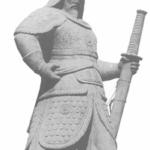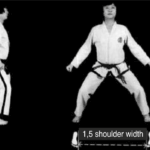Historical background
“DO-SAN” is the pseudonym of the patriot AHN CHANG HO (1876-1938).
The 24 movements represent his entire life which he devoted to furthering the education of Korea and its independence movement.
Meaning of the yellow belt (ti)
Green: The color of the plant that grows and develops, as the skills in Taekwondo increase.
Knowledge for the 6th Kup
The phases of a movement
In TUL and MATSUGI it is important to finish correctly each executed techniques. Therefore, let’s take a closer look.
Ex: we perform ORUN GUNNUN SOGI, NAJUNDE BAKKAT PALMOK MAKGI.
-
-
- The first phase is the preparatory phase: we progress forward and we put our defense up. During this phase, we use an undulating motion to develop speed.
- The second phase is the moment of the impact: this is the moment when the part of the body that performs the defense against the object to be blocked, is hit. At the time of the impact, our body is tensed in order to pass on the power and speed which we have developed through the part of the body, that carries out the blocking, to the object to be blocked.In short, we need to move that we developed in the first phase to the end.
It is important that the motion of the legs, the arm movements and respiration are simultaneous. It is only in this case possible to carry out a powerful technique. - The final phase is the phase of the relaxation of the muscles because the defense is already completed. It is only when the muscles are relaxed that we can perform the next move.
-
The Dynasties
Current North and South Korea earlier consisted of three dynasties: the Koguryo, Baekje and Silla Dynasty :
-
- Koguryo (37 B.C. to 668 A.D.)
- Paekje (18 to 600 B.C. A.D.)
- Silla (57 to 935 B.C. A.D.)
Silla unified the kingdoms together by winning the war against Paekje in 660 AD and Koguryo in 668 AD. What followed was a time of peace and HwaRang grew from a military organization to a group specialized in poetry and music.
In 936 AD when Wang Kon founded the Koryo dynasty (an abbreviation of Koguryo). The Korean name KoryoIn derives from the Silla Dynasty, the principles of Taekwondo began with the youth group Hwarang DO. At that time the martial art that this group performed was called Taekyon or SOO BIN GI because the name “Taekwon-do ‘ only came into place in 1955.
Modern Taekwondo is a combination of many other martial arts. The most important of these is the Japanese Karate. This is because Japan occupied Korea from 1910 to the end of the World War II. During this war, lots of Korean soldiers were trained in Japan. During this occupation Japan tried to erase all traces of the Korean culture, including eliminating the traditional martial arts. The influence that Karate has on Taekwondo enriched the quick linear movements also used in Taekwondo.
After World War II, when Korea became independent, several kwans arose. These were:
-
-
- Chung Do Kwan
- Moo Duk Kwan
- Yun Moo Kwan
- Chang Moo Kwan
- Oh Do Kwan
- Ji Do Kwan
- Chi Do Kwan
- Song Moo Kwan
-
The Kwan united in 1955 as Tae Soo Do. In the beginning of 1957, the name Taekwondo was set equal to the name Tae Kyon by several Korean martial arts masters.
General Choi Hong-Hi required the army to train Taekwondo. Thus the first Korean soldiers were Taekwondo students. The police and air force had to learn Taekwondo. At that time Taekwondo was merely a Korean version of Shotokan Karate.
Hand technique for 6th Kup
| Korean | English |
| NOPUNDE BAKAT PALMOK MAKGI | High outer forearm block |
| AP JOOMUK BANDAE JIRUGI | Front forefist middle reverse punch |
| SUN SONKUT BARO TULGI | Straight fingertip thrust |
| JAEP SYUL TAE | Release from grab |
| DUNG JOOMUK NOPUNDE YOP TAERIGI | Back fist high obverse side strike |
| BAKAT PALMOK NOPUNDE HECHYO MAKGI | Outer forearm high wedging block |
Foot technique for 6th Kup
| Korean | English |
| APCHA BUSIGI | Front snap kick |
Positions for 6th Kup

